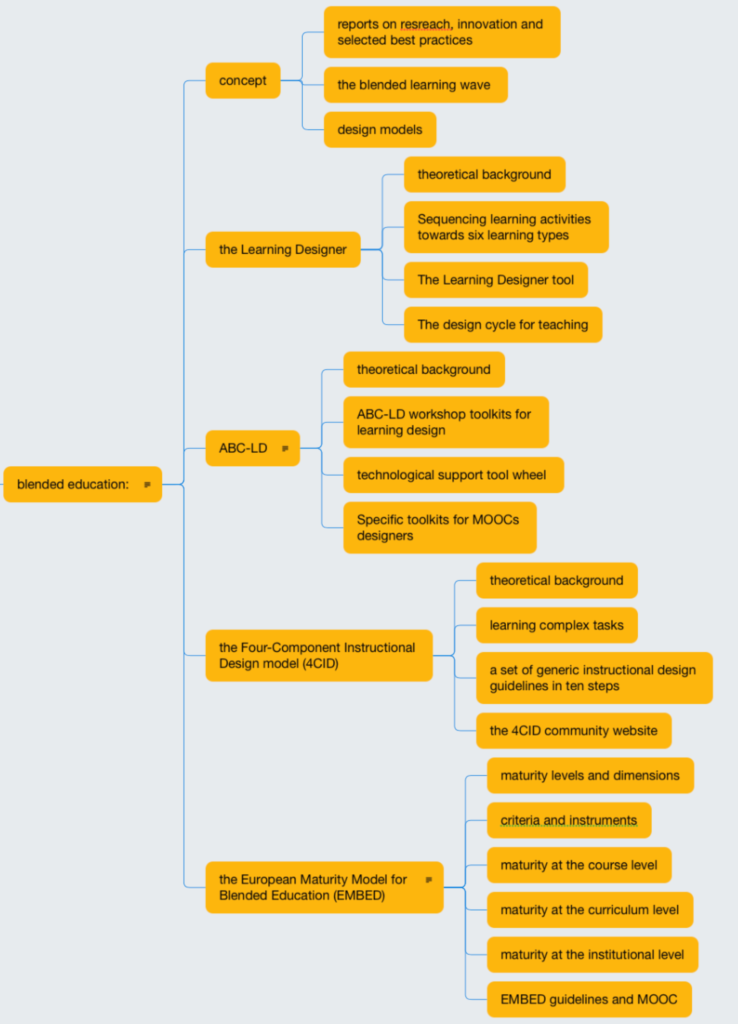
Blended education is illustrated with reports on research, innovation and selected best practices. The blended learning wave and design models and guidelines are presented:
- the Learning Designer;
- ABC Learning Design (ABC-LD);
- Four Component Instructional Design (4CID);
- the European Maturity Model for Blended Education, which assesses informed decisionmaking about blended education.
Concept
Blended teaching and learning with a mix of synchronous and asynchronous methods is based on a course design with a deliberate combination of online and offline teaching and learning activities (Graham, et al., 2013; Goeman et al., 2019; Dijkstra & Goeman, 2020; van Valkenburg et al., 2020). Key word here is “deliberate”, as blended education is subject of thoughtful educational design. Teaching has to be understood as a design science (Laurillard, 2015), similar to other action sciences such as architecture.
Blended teaching means “respecting the true value of conventional methods – such as lectures, seminars, tutorials, projects, labs, field trips, physical material. And it means recognizing the extraordinary power and flexibility of digital technologies” The value of combining of the two is that digital methods can offer more opportunities for “more personalization, flexibility, inclusiveness and efficiency than conventional methods, but they must be used appropriately” (Laurillard, 2015).
Digital doesn’t complement and simply replicate aspects of the conventional. One should amplify the other.
Research, innovation and best practices reports
An overview of the recent research literature on blended education is found in recent European projects such as EMBED and DigiTeL Pro:
Goeman, K., Poelmans, S., Van Rompaey, V. (2019), Research report on state of the art in blended education and innovation. Retrieved from the European Maturity Model for Blended Education
website: https://embed.eadtu.eu/results
Wahls, N., Dijkstra, W. and Ouwehand, M. (2022). Blending Your Education: Lessons Learned During COVID. DigiTeL Pro. Project funded by the European Commission. EADTU.
https://digitelpro.eadtu.eu/outcomes
Brouns, F., Albert S., Beirne, E., Ouwehand, M., Pieters, M., Ricco, I., Compendium of good practices
responding to the need of universities during the COVID crisis and beyond. Digital Pro, project
funded by the European Commission.
https://digitelpro.eadtu.eu/images/DigiTeLPro_IO1_A2_Compendium.pdf
The blended learning wave
The blended learning wave in Fig. 9 and 10 reflects how blending of learning can be designed in practice, combining offline and online teaching formats during a course timeline. Blended course features are used in order to facilitate student learning, informed by evidence or experience, and continuous quality improvement is deliberately embedded in order to enhance student learning. (van Valkenburg et al., 2020)
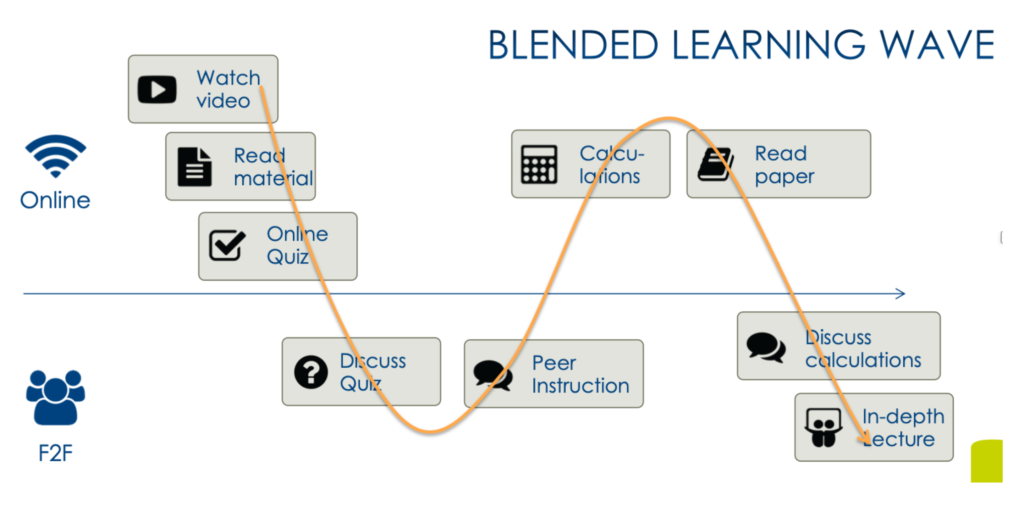
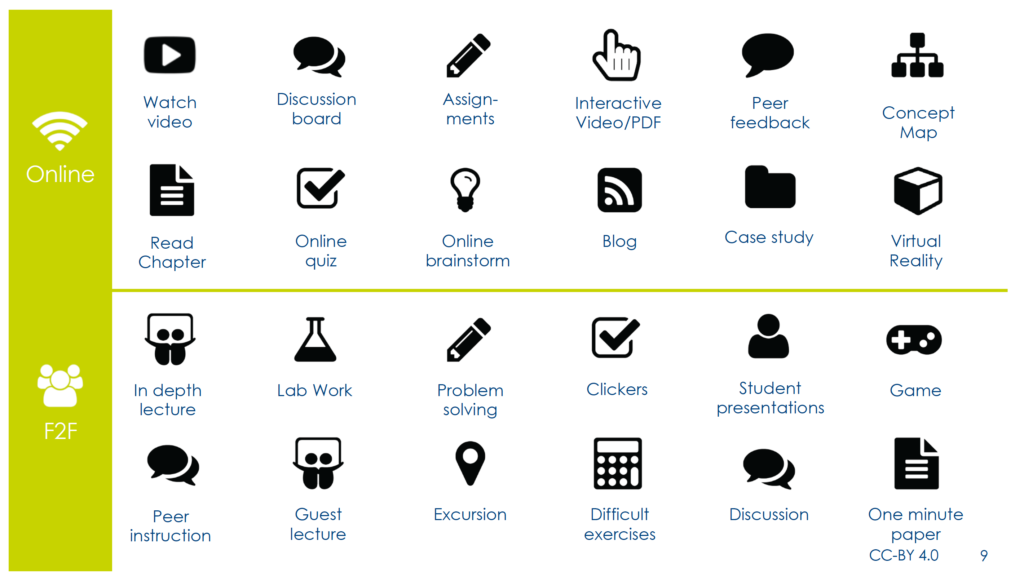
Design models
Models are developed for the design of blended courses and curricula and are already being applied in many European universities, for example:
- the Learning Designer by Laurillard of Knowledge Lab of the University College of London is based on the conversational theory of learning and makes connections with different types of learning (Laurillard, 2021), see also the Futurelearn course (UCL, 2022);
- ABC-Learning Design (ABC-LD) by Young and Perovic of the University College of London offers a practical toolkit for course and programme teams for teaching and learning design, based on main features of the Learning Designer (Young and Perovic, ABC-LD, 2022)
- The Four Components for Instructional Design model (4CID) by van Merriënboer et al. of the University of Maastricht and Open University of the Netherlands offers a teaching and learning design model, dividing complex learning in tasks and subtasks (4CID, 2022)
These three models are outlined in the following paragraphs.
The Learning Designer
The Learning Designer model is closely linked to Laurillard’s conversational theory of learning and to the six learning types described in “Teaching as a Design Science” (Laurillard, 2012). Learning activities are described in connection with these forms of learning. The Learning Designer provides tools that can be used very practically by teachers and course designers.
Theoretical background
In the conversational theory of learning, the teaching learning process is basically represented as “series of exchanges between a learner and a teacher, and between a learner and their peers, at two levels: of concepts and practices” The heart of the framework is a simple way to think about how a learner is learning. They have some concepts, or knowledge, and they have some practices, or skills (Laurillard & Kennedy, 2022):
- At the concept level, there are continual iterations of ideas, as they gradually develop a concept, and join it up with other concepts.
- At the practice level as well, there are continual iterations of actions that gradually develop a skill, and then gradually more complex skills
- It’s also important that the concepts influence the learner’s practice, and v.v., in another continuous cycle.
The theory says that for learning in formal education teachers have to make sure these continual cycles are actually working, and students are indeed developing their concepts and practices together.
Sequencing learning activities towards six learning types
The Learning Designer supports teachers in designing learning experiences as teaching and learning activities (TLAs) that will enable learners to meet those outcomes.
A core component in this design model the six learning types, drawn from Laurillard’s “Conversational Framework”.
The Learning Designer tool prompts teachers to select from a drop-down list of these six learning
types that best describes each activity they create: is it learning from acquisition (Read/Watch/Listen)?
Learning from inquiry? Learning from practice? Learning from production? Learning from discussion? Or learning from collaboration?
Below, examples are given of learning activities for each the learning types (Laurillard, 2012; Young
and Perovic, 2015):
- Learning through acquisition
Learning through acquisition is what learners are doing when they are listening to a lecture or podcast, reading from books or websites, and watching demos or videos.
Examples conventional methods: reading books, papers; listening to teacher presentations face to face lectures; watching demonstrations, master classes;
Examples digital technology: reading multimedia, websites, digital documents and resources; listening to podcasts, webcasts; watching animations, videos, ebooks; journal articles; websites; recorded lectures/slides; multimedia learning objects, demonstrations, simulations; podcasts/audio files; YouTube; web conferencing/virtual classrooms; glossaries. - Learning through investigation
Learning through investigation guides the learner to explore, compare and critique the texts,
documents and resources that reflect the concepts and ideas being taught.
Examples conventional method: using text-based study guides, analyzing the ideas and information in a range of materials and resources, using conventional methods to collect and analyze data, comparing texts, searching and evaluating information and ideas; field/lab observations
Examples digital technology: using online advice and guidance, analyzing the ideas and information in a range of digital resources (e.g. literature review), using digital tools to collect and analyze data,
comparing digital texts, using digital tools for searching and developing information and ideas. - Learning through discussion
Learning through discussion requires the learner to articulate their ideas and questions, and to
challenge and respond to the ideas and questions from the teacher, and/or from their peers.
Examples conventional method: tutorials, seminars, discussion groups, class discussions; small group
or paired discussions.
Examples digital technology: online tutorials; webinars, e-mail discussions, discussion groups
discussion forums; synchronous and asynchronous web-conferencing tools, virtual classrooms;
portfolio sharing/commenting; audience polls or surveys; glossary commenting. - Learning through collaboration
Learning through collaboration embraces mainly discussion, practice, and production. Building on
investigations and acquisition it is about taking part in the process of knowledge building itself.
Examples conventional method: small group project, discussing others’ outputs, building a joint output in physical classroom space.
Examples digital technology: small group projects using online forums, discussion on others’ outputs
online; discussing others’ outputs, building a joint digital output, building a joint output together (eg a wiki, website, glossary, report, presentation or video); a peer review cycle. - Learning through practice and feedback
Learning through practice enables the learner to adapt their actions to the task goal and use the feedback to improve their next action. Feedback may come from self-reflection, from peers, from the teacher, or from the activity itself, if it shows them how to improve the result of their action in relation to the goal.
Examples conventional method: practicing exercises, doing practice-based projects, labs, fieldtrips, face-to-face role play activities.
Examples digital technology: using models simulations, microworlds, virtual labs and field trips, online role play activities, use of models; use of simulations/augmented reality/virtual reality. - Learning through production
Learning through production is the way the teacher motivates the learner to consolidate what they have learned by articulating their current conceptual understanding and how they used it in practice.
Examples conventional method: statements, essays; reports, accounts, designs, performances, artefacts, animations, models, videos.
Examples digital technology: producing and storing digital documents; wikis; interviews; representations of designs, e.g. mindmaps; performances; artefacts; animations, models; resources; slideshows; photos, videos; blogs.
The Learning Designer tool
For each teaching and learning activity, the teacher describes the session making use of Learning Designer tool with a set of specifications in timeline of the course (Fig. 11):
- name and topic of the session;
- learning time;
- size of the class;
- description of the session;
- mode of delivery: wholly online; blended; class-based;
- learning type: watch-read-listen; investigate; discuss; collaborate; practice; produce (learning
types can always be added) - teacher present or not;
- online/offline;
- synchronous/asynchronous;
- resources linked or not;;
- notes, can always be expanded or added.
Importantly, existing designs can be imported. For design import, the learning designer tool provides a directory with existing designs in different subject areas.
Designs in progress can be exported or shared (Fig. 12)
Given these specifications, the tool provides an analysis of the session, e.g. by graphs on a social learning, types of learning, presence of the teacher, asynchronous/asynchronous learning, face-toface/online learning.
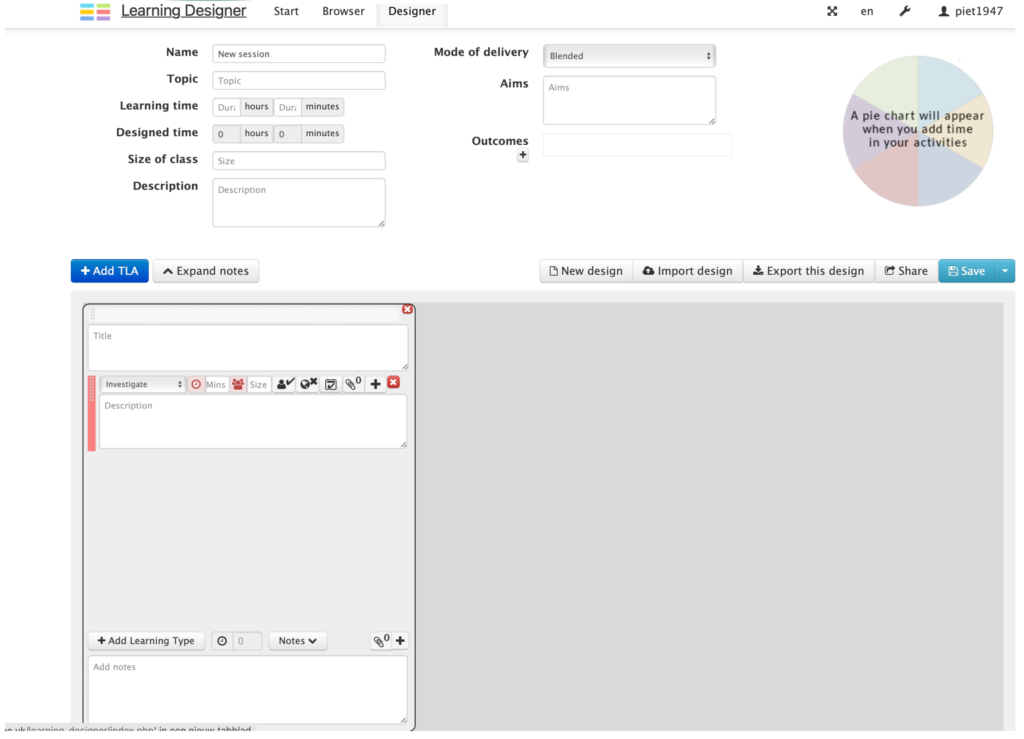
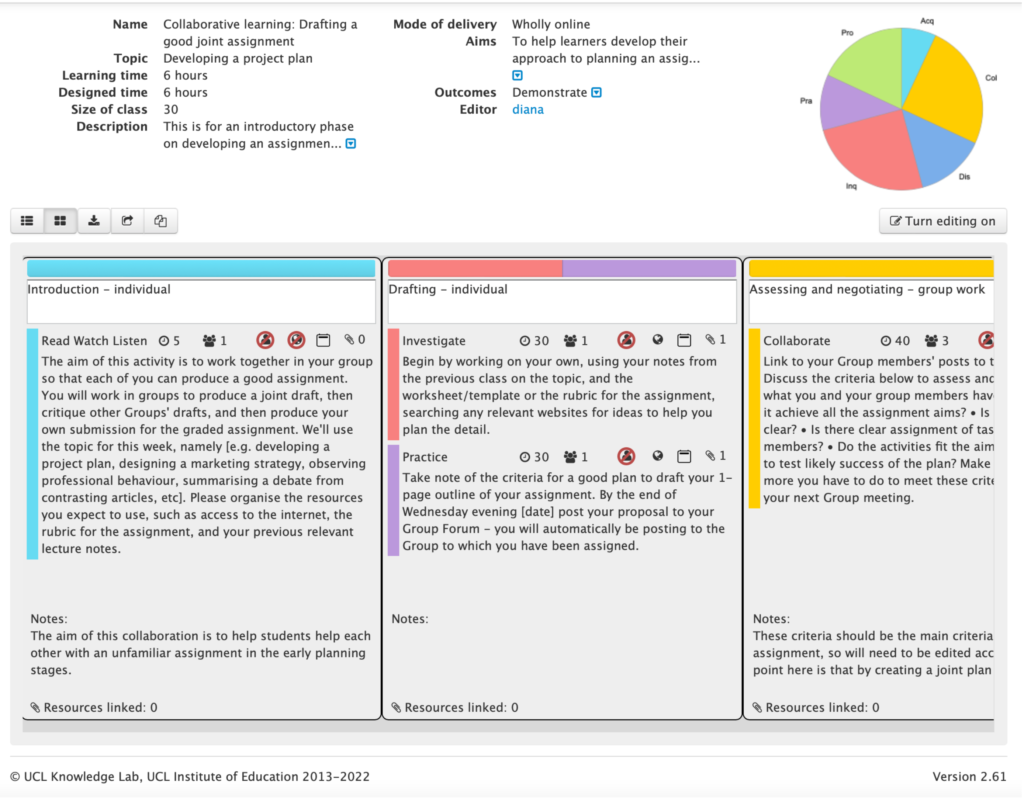
The Learning Designer tool provides tutorials on YouTube:
https://www.youtube.com/watch?v=S0edRboC9vI
Also, a MOOC on the Learning Designer is available on the FutureLearn portal: UCL (2022), Blended and online learning design. Futurelearn MOOC.
https://www.futurelearn.com/courses/blended-and-online-learning-design
The design cycle for teaching
The teaching and learning design cycle consists of sequential steps, all of which can be set up within the Learning Designer tool:
- Browse and adopt: teachers can browse existing designs and adopt them for their own design;
- Adapt or create: teachers can select a design from the design directory to edit and adapt or they can create the learning experience from scratch;
- Analyze and review: teachers can analyze and review the learning experience they are designing with data from the tool;
- Redesign: teachers can redesign the learning experience;
- Test: teachers can test their design during and after implementation;
- Share and publish: teachers are encouraged to share their design with peer teachers for peer review and publish in the public space.
This educational design cycle is analogous to the research design cycle and supports the building of educational community knowledge.
ABC-Learning Design (ABC-LD)
ABC Learning Design it’s based on the same theory as the Learning Designer. It consists of toolkits and guidelines for course and programme teams for designing and developing courses and programmes. Specific toolkits are developed for the design of MOOCs (Futurelearn, EdX)
Theoretical background
The ABC-Learning Design (ABC-LD) (Young & Perović, 2015) is based on “ Laurillard’s Conversational Framework”, and on curriculum design research from JISC (Viewpoints project, 2008-2013).
It builds on the six learning types concept as described above and is adapted for design of programmes, modules, short courses and MOOCs. See: https://abc-ld.org
ABC Learning Design is a hands-on curriculum development workshop toolkit developed at UCL. In just 90 minutes teaching teams work together to create a visual ‘storyboard’. The storyboard is made up of pre-printed cards representing the type and sequence of learning activities (both online and offline) required to meet the module or programme learning outcomes.
The ABC team has introduced the method to 35 universities and colleges throughout the UK, Europe,
including the LERU universities and beyond.
ABC-LD workshop toolkits for learning design
ABC-LD presents a toolkit for course/curriculum teams for designing blended teaching and learning in sequential steps in a team workshop:
A team workshop starts with a storyboard, planned on a learner timeline, representing the goals, modules and sub-sections or topics for a module, course or curriculum.
The storyboard is made up of pre-printed cards representing the type and sequence of learning activities (both online and offline) required to meet the module or programme learning outcomes. Definitions of learning types are printed at one side of the cards and examples of activities at the other. The cards are sequenced as showcased in Fig. 13 and 15.
After sequencing the learning type per topic, the cards are turned to the other side and learning activities are selected.
An extensive list of examples of learning activities per learning type is given in Fig. 14.
The draft modules can then be evaluated in a team/peer discussion, making use of the learning types and activities graph.
Finally, an action plan is developed indicating who and when the topics will be developed.
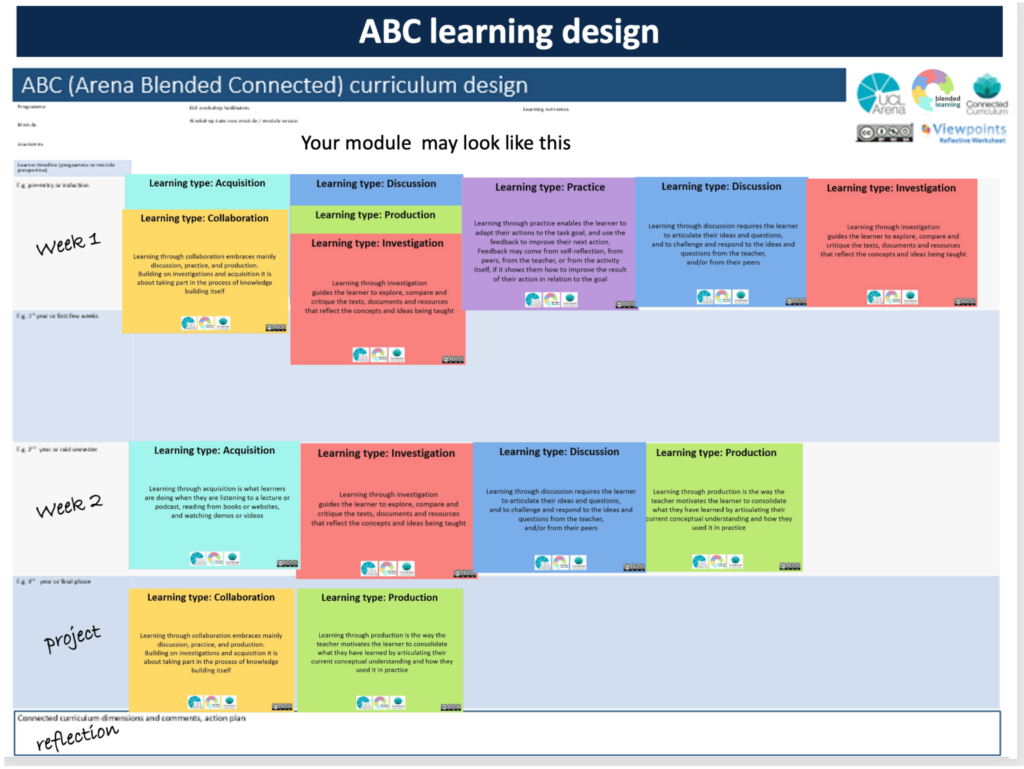
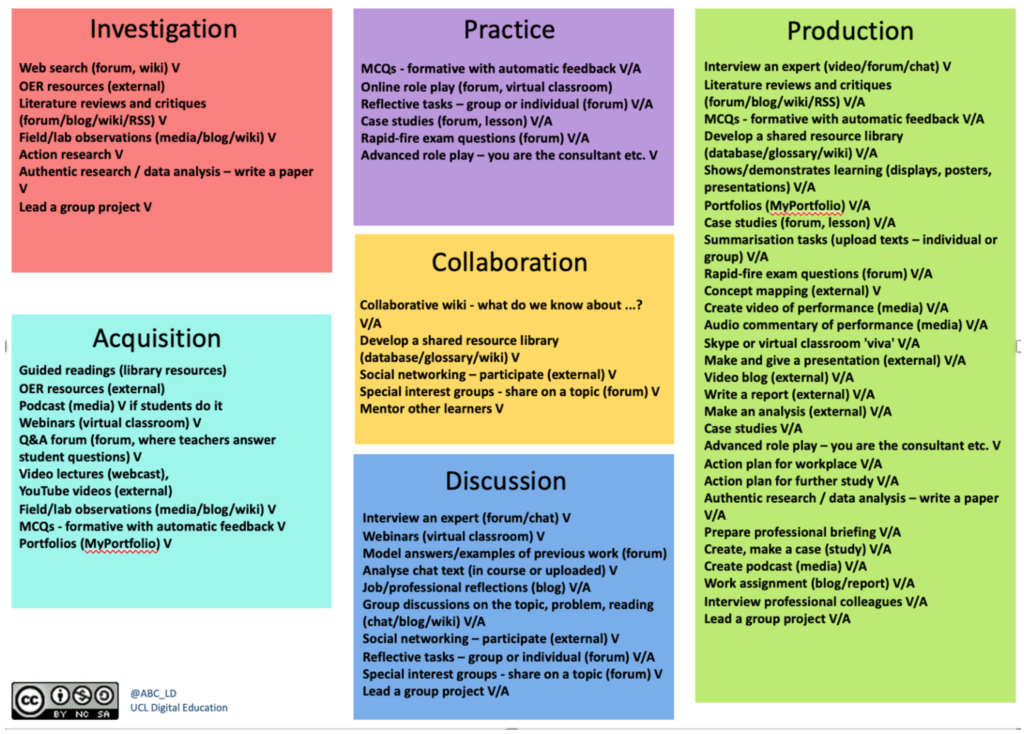
(ABC-LD toolkit)
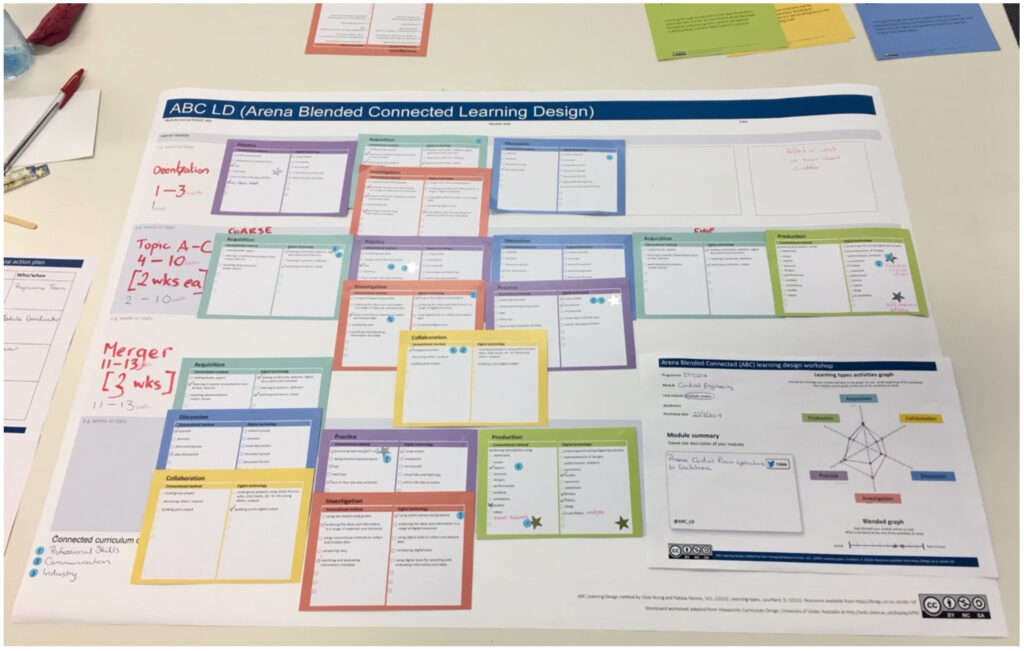
Technological support tool wheel
ABC-LD has created a technology tool wheel for UCL with software that can support the mentioned activities. Of course, universities should include a software registry supported by them and regularly
replenish and revise the wheel (Fig. 16)
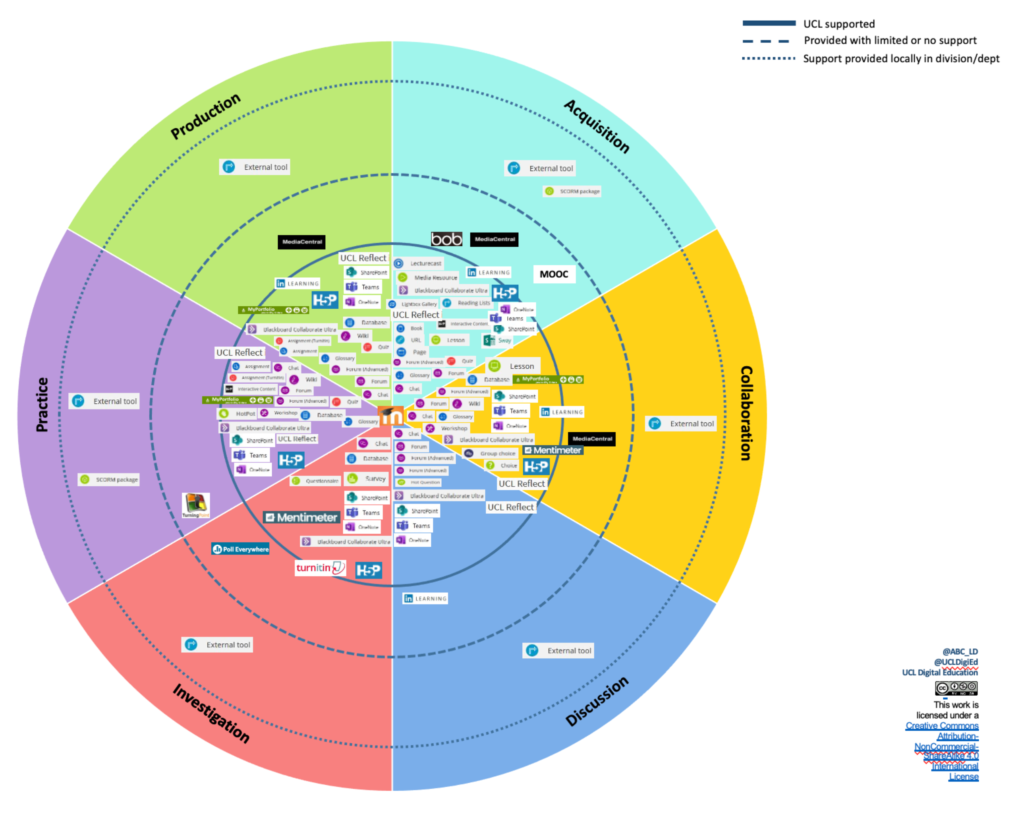
Specific toolkits for MOOCs designers
On the ABC-LD website, specific toolkits are published for the design of MOOCs, specifically for Futurelearn (UCL) and EdX (Castelein & Vanderstappen, KU Leuven).
See: https://abc-ld.org/?s=MOOC
The Four-Component Instructional Design model (4CID)
The Four-Component Instructional Design model starts with real, professional complex tasks that are
then broken down into less complex subtasks. The 4CID website includes guidelines, a video
presentation, examples of good practice, a user community and publications (https://www.4cid.org)
Theoretical background
As described on the 4CID website, 4CID is “an instructional design approach for complex learning. This is learning aimed at integrative learning goals where knowledge, skills, and attitudes are developed simultaneously in order to acquire complex skills and professional competencies. It provides guidelines for the analysis of real-life tasks and the transition into a blueprint for an educational programme. It is typically used for designing and developing substantial educational programmes ranging in length from several weeks to several years and/or that entail a substantial part of a curriculum”. The 4CID model was originally created by van Merriënboer (van Merrienboer, 2012).
The model can be applied to design entire courses/curricula, it can also lead to improvement if only parts of the model are used.
The model combines social constructivist and traditional ‘instructivist’ approaches to teaching and learning, complementing “the best of both worlds”.
Learning complex tasks
4CID refers to four components in instructional design for complex learning: learning tasks, supportive information, procedural information, and part-task practice (Fig. 17).
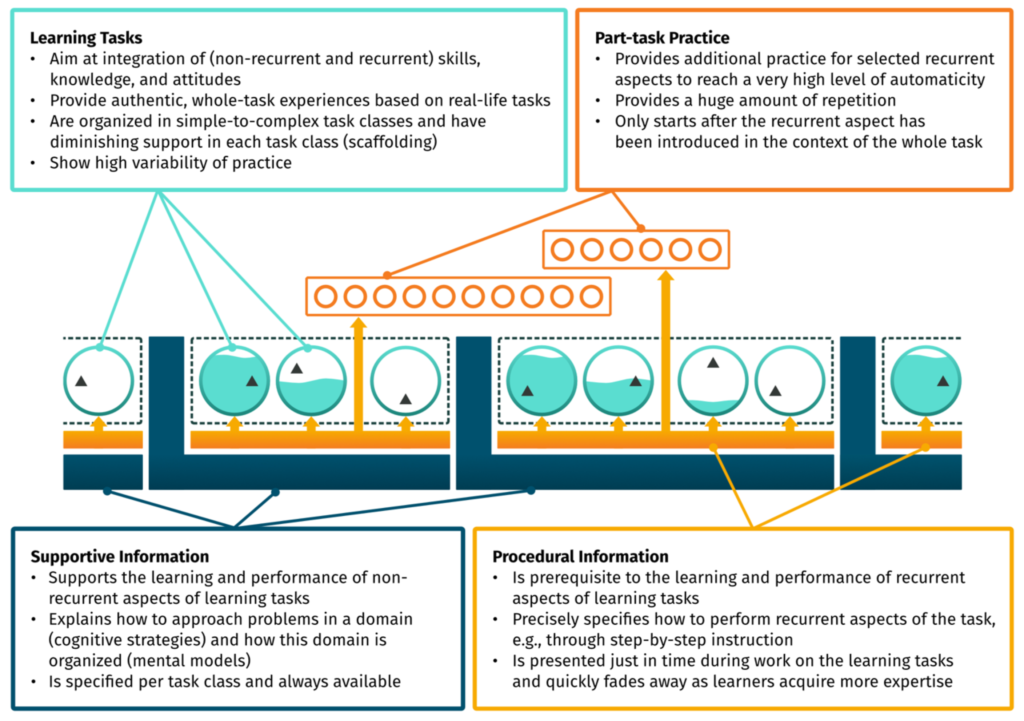
procedural information, and (d) part-task practice, by Jeroen J. G. van Merriënboer, 2020,
https://www.4cid.org. CC-BY-SA 4.0
The term complex learning was introduced in the 1990s to refer to forms of learning aimed at the
integration of multiple objectives. This is frequently encountered when instruction must reach beyond a single lesson or course, for example, when professional competencies or complex skills are taught.
Complex learning takes a holistic rather than atomistic perspective on learning and teaching processes.
4CID learning can be personalized by dynamic task selection as the model also allows flexibility. Based on the assessment of previous learning tasks, learners or teachers can make informed choices for the most suitable learning task to carry out next. It is possible that different learners are working on different learning tasks at the same time.
A set of generic instructional design guidelines in ten steps
The Ten Steps is a practical, systematic approach to apply the 4C/ID model. It describes steps to help designers create the four components and perform an analysis to collect the information needed for the
design. The Ten Steps function is a practical guide to create an instructional blueprint based on 4CID
and includes a collection of heuristics to help designers complete each of the steps:
- Design learning tasks
- Design performance assessments
- Sequence learning tasks
- Design supporting information
- Analyze cognitive strategies
- Analyze mental models
- Design procedural information
- Analyze cognitive rules
- Analyze pre-requisite knowledge
- Design part-task practice.
All steps are consistently guided by evidence-based cognitive psychological principles.
An interactive lecture on the 4CID website (https://www.4cid.org) explains each of the steps and
associated concepts in detail. (see also: Frerejean et al., 2021).
A 4CID video-course is presented here: https://canvas.instructure.com/courses/5234251 (Frerejean and van Merriënboer, 2022)
The 4CID community website
The 4CID design model is supported by the extensive website with publications, courses, presentations, examples and a user community. Events are regularly organized and a newsletter is issued.
Consultancy sessions are provided on demand.
The European Maturity Model for Blended Education
Looking to everyday practice, blended learning shows different levels of adoption, from a low probably intuitive adoption level to evidence-based or informed practices.
The degree to which deliberate and informed decision-making processes are embedded in blended
learning practices determines the maturity level of blended education. Therefore, maturity is a measurement of the ability of an institution, programme board or course team for continuous
improvement of the quality of education in a particular discipline. Maturity does not equate to quality,
but it contributes to quality improvement.
The European Maturity Model for Blended Education (EMBED) is offering guidance for iterative pedagogical and institutional change. It is a multi-layer model, including micro-level teaching and
learning processes, meso-level institutional innovation and enabling strategies and the macro- level
governmental policy and support structures.
Maturity in blended education is achieved when the blended design of a course, curriculum or
institutional policy is regularly evaluated and improved. In EMBED, the different maturity levels of
blended design are defined and guidelines for improvement are presented for each of the design
dimensions (Dijkstra and Goeman, 2021).
Maturity levels and dimensions
The EMBED Maturity levels can be assessed by the instrument developed by KU Leuven and TUDelft.
The maturity dimensions in EMBED are based on most recent literature research (Goeman, Poelmans, & Van Rompaey, 2018), on the evaluation of best blended course development practices and institutional strategies, and on a Delphi research on the results of these investigations (Goeman, Dijkstra, Poelmans, Vemuri, & van Valkenburg, 2021).
The EMBED model uses a multilevel and multi-stakeholder approach:
• At the course level, the maturity is assessed for course and curriculum design according to six dimensions: the selection and sequencing of learning activities, the selection of blended learning tools, course flexibility, course interaction, the student learning experience, and study load and inclusiveness.
• At the programme level, the maturity level is assessed according to six dimensions: programme coherence, alignment and coherence of blended learning tools, programme flexibility, the student learning experience, study load, and inclusiveness.
• At the institutional level, the maturity level is assessed according to eight dimensions: institutional strategy, institutional support, sharing and openness, institutional development, quality assurance, governance, finance, and facilities.
• At the policy level, recommendations are developed for policy makers. For each dimension, guidelines are developed to optimize processes leading to systemic decision-making (Goeman & Dijkstra, 2021).
Criteria and instruments
For each dimension, criteria and instruments are developed to assess and map the degree of maturity
of blended education for each of these maturity dimensions. For each dimension, a high, medium, or
low maturity level can be represented in a spider diagram (fig. 18).
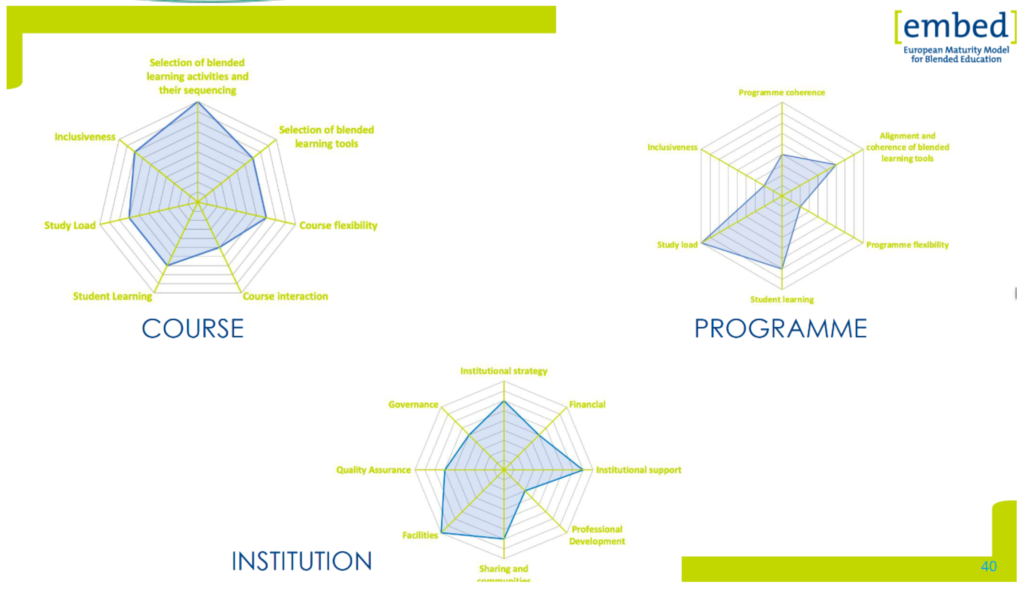
Maturity at the course level
The course level ‘refers to the core of the educational system, where both learning processes and
instructional processes are situated’. It refers to the primary educational process, in other words the
development, execution and evaluation of courses. The stakeholders of this level are mainly teachers/educators and students, but also instructional designers, learning developers, content
developers and sometimes management (fig. 19).
Dimensions:
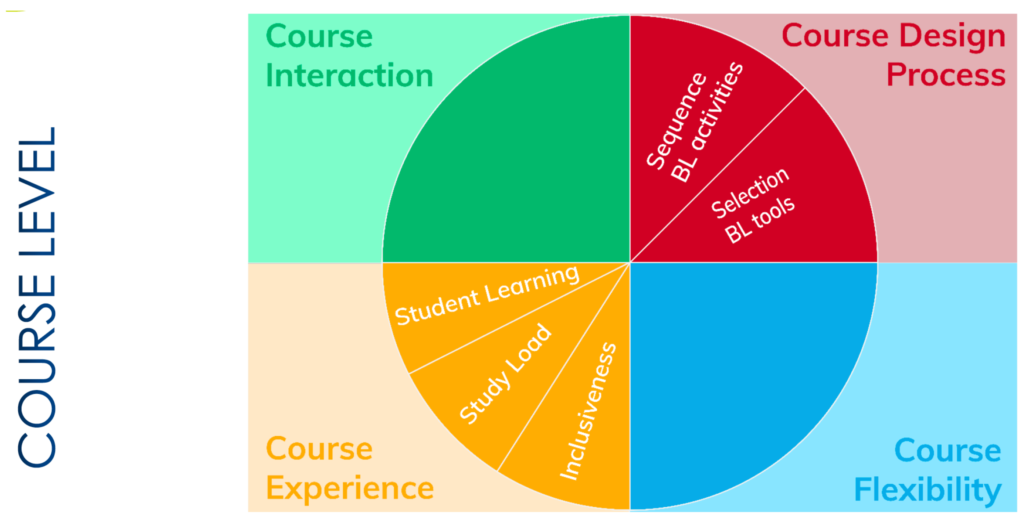
- The organization of blended learning activities and their sequencing: the rationale for the
deliberate selection and integration of face-to-face and online learning activities.
Learning activities (both face-to-face as online) are deliberately selected, integrated, and
sequenced based on a design method or design principles. Quality assurance processes are
deliberately embedded in order to continuously improve a course in an iterative manner. - The selection of blended learning tools: the rationale for selecting tools for delivery and
organisation of blended learning activities.
The selection of tools and media is based on learning activities, informed by evidence or
experience. This process is monitored, evaluated and changed based on quantitative and
qualitative data; - Course flexibility: opportunities for learners to adjust particular features of the blended learning
course, based on their needs and preferences. This includes features such as the selection of
learning activities, the selection of resources, the mode of delivery (online/face-to-face activities),
pace (educator-paced/self-paced). The offering (or not offering) of course flexibility is deliberately
designed, informed by evidence or experience. The flexibility is adapted based on the learners’
needs. Continuous quality improvement is deliberately embedded in order to enhance course
flexibility. - Course interaction: the extent to which the blended course facilitates learners’ interaction
(learner-content, learner- learner, learner-educator). Interaction in the course is deliberately
designed, informed by evidence or experience. Interactions are monitored, evaluated and changed
based on data and feedback. - Student learning: the use of blended course features which facilitate students’ self-regulated
learning (orienting and planning, monitoring, adjusting and evaluating). Blended course features
are used in order to facilitate student learning, informed by evidence or experience, and
continuous quality improvement is deliberately embedded in order to enhance student learning. - Study load: the match between the intended and achieved study load of a course (distribution and
correctness): course study load is calculated based on data and experience. All course elements
(e.g. online learning activities, face-to- face learning activities, exam preparations) are taken into
consideration for the calculation of the study load. The study load is monitored, evaluated and
changed based on quantitative and qualitative data. - Inclusiveness: the consideration for the diverse needs (including accessibility aspects) and
backgrounds of all students to create an online and face-to-face course experience where all
students feel valued, safe, have a sense of belonging, and where all students have equal access to
learn.
Maturity at the programme level
The programme level refers to educational programmes or curricula. A programme is a structured
series of educational courses. The stakeholders of this level are mainly teachers/educators and students, but also instructional designers, learning developers, content developers and the management (fig. 20).
Dimensions:
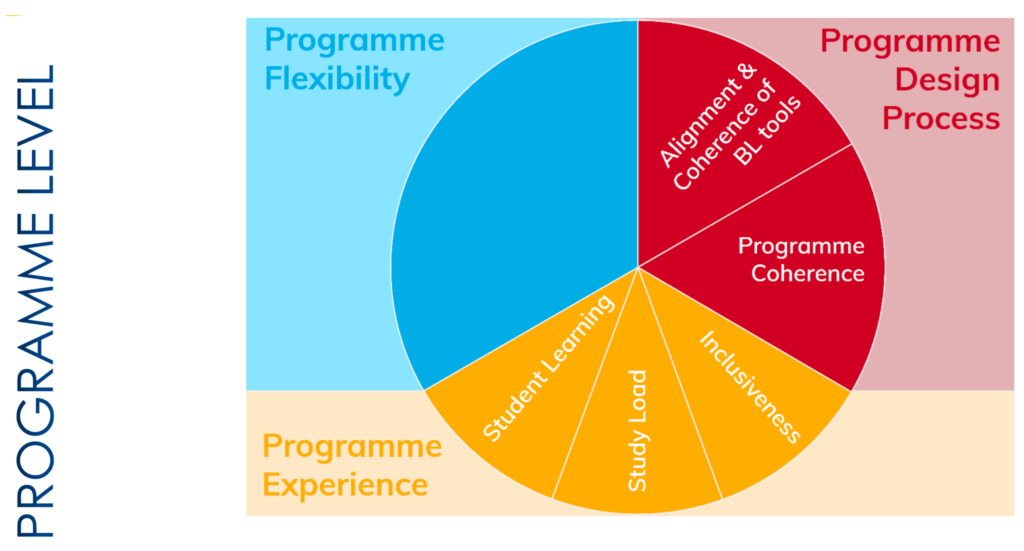
- Programme coherence: the vertical (course-programme) and horizontal alignment (between
courses) of a blended programme.
Deliberate consideration for the horizontal and vertical alignment in the blended programme design
cycle, based on a shared vision on blended learning and design method and principles. Continuous
quality improvement is implemented in order to enhance a programme in an iterative manner. - Alignment and coherence of blended learning tools: the rationale for the alignment and coherence
of educational tools in a blended learning programme.
The alignment and coherence of the tools used in a programme are based on learning activities in
courses, coordinated by the educators in the programme and informed by evidence or experience. This process is monitored, evaluated and changed based on quantitative and qualitative data. - Programme adaptive flexibility: opportunities for learners to adapt particular features of the
blended learning programme.
This includes features like the selection of courses/tracks, the mode of delivery (blended courses,
online course, traditional course), workload (full time/part time), pace (institution paced/self-paced),
study progress in the programme, possibility to follow courses in other institutions.
The flexibility in a programme is deliberately designed. Learners have a lot of opportunities to adapt
particular features of the blended learning programme and receive advice on their options. The
offering of flexibility is based on evidence or experience. Flexibility is monitored, evaluated and
changed based on quantitative or qualitative data. - Programme modularity: The extent to which programme components (e.g. courses, parts of courses,materials) are designed with modularity in mind, so they can be reused in other educational contexts.
Programme components are designed with modularity in mind and are reused in other educational
contexts. Continuous quality improvement is deliberately embedded in order to enhance quality of the programme components. - Student learning (programme experience): The use of blended programme features which facilitate
students’ self-regulated learning (orienting and planning, monitoring, adjusting and evaluating).
Students are guided and supported throughout the blended programme on self-regulating their
learning. The blended aspect of the programme is internalized in all processes for the students and
teaching staff. These processes are monitored, evaluated and adjusted based on quantitative and
qualitative data. - Study load (programme experience): the match between the intended and achieved study load of a
programme (distribution across courses and correctness).
The study load, including deadlines, of different courses in a blended programme are aligned,
monitored, evaluated and adjusted. - Inclusiveness (programme experience): the consideration of the diverse needs and backgrounds of
students in order to create a programme where all students feel valued, safe, have a sense of belonging, and where all students have equal access to the blended learning programme.
The inclusiveness between all courses of a programme is aligned. The realization of inclusiveness is
based on evidence or experience. Continuous quality improvement is deliberately embedded in order to improve inclusiveness in the programme.
Maturity at the institutional level
The institutional level refers to the formal context of blended learning and education. This is determined by policies and conditions with regard to the organization and support of blended learning. At the institutional level different key actors, teams, or bodies play a role in the decision- making process. Among others, programme coordinators and heads of teaching and learning centers are involved (fig.21).
Dimensions:
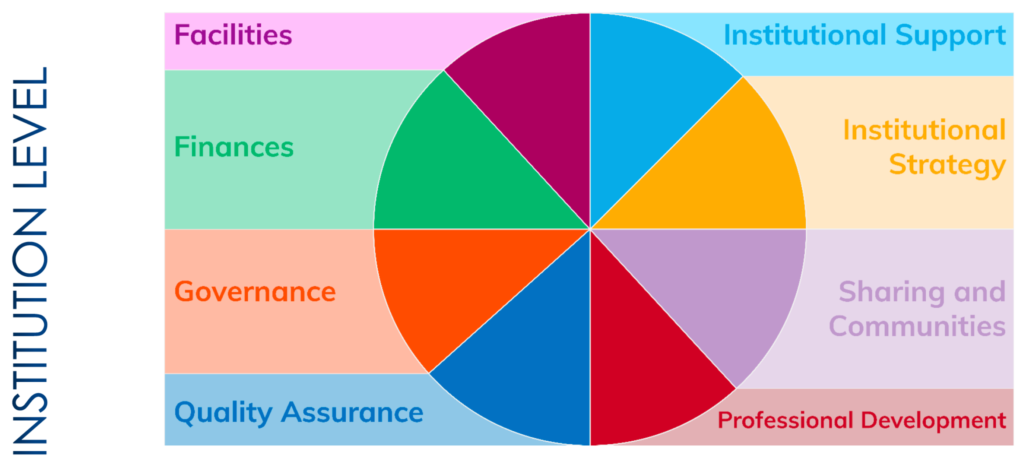
- Institutional strategy: the extent to which blended learning, teaching and education are embedded
in the vision, educational model and goals of an institution
Blended learning is an integral part of the institutional strategy. The strategy is embedded in the
whole institution (throughout faculties and departments), well documented, and evaluated and
adjusted on a regular basis. University administrators and departments recognize and advocate for
the importance of blended learning, teaching and education. - Institutional support: the manner in which an institution supports teachers and students’ blended
learning activities
Dedicated support for blended learning and teaching is available for all
teachers, students and departments and is part of the standard support services of the institution.
Continuous quality improvement is deliberately embedded in order to improve the support for
blended learning. - Sharing and communities: the degree to which an institution facilitates communities for sharing
blended practices, materials and courses
Communities for sharing ‘blended’ best practices are facilitated, actively built and maintained.
Processes and platforms are in place for sharing good practices and materials. Processes are in
place for quality assurance of the shared materials. - Professional development: The extent to which teaching staff are able to develop their blended
teaching skills
All teaching staff is trained in blended learning and teaching. The institution offers a well aligned
portfolio of workshops and/or courses (related to blended learning and teaching) for the
continuous professional development of their staff. The blended teaching activities of staff are
recognized and valued by the institution. - Quality assurance: The process where blended courses, programmes, strategy, rules and
regulations are evaluated and revised on a regular basis
Quality assurance for blended courses is part of the standard quality assurance processes of the
institution. The evaluation and improvement are based on clear criteria and multiple data sources.
The institution has a research agenda for researching its own courses, programmes and education. - Governance: the way in which the vision and policies are translated to rules, regulations and
actions that facilitate blended education
Policies, rules, regulations, action plans and guidelines (e.g. legal, ethical, privacy & data) related
to blended learning are embedded in the standard governance
structure of the institution. The governance of the institution is systematically reviewed and
adjusted. Key actors, at different levels in the institution, are involved in the process of reviewing,
adjusting and developing new and existing policies, rules, regulations and action plans.
Standardized models for blended course and programme development are provided. - Finances: the extent to which financial resources are allocated to develop, support, and stimulate
blended learning
Financial resources are structurally allocated to develop, support, stimulate and improve blended
learning, teaching and blended education. The allocation of the resources is systematically
evaluated and adjusted, based on clear criteria and qualitative and quantitative data. - Facilities: the extent to which institutions are equipped to facilitated blended learning and
teaching.
A wide variety of facilities is available. This includes both digital (e.g. digital learning environment, educational tools) as physical (e.g. the availability of different classroom set-ups, video recording studios) facilities. Teachers have influence on the scheduling of the facilities. The development of facilities is aligned with the institutional strategy. The quality, quantity and assortment of facilities is systematically evaluated and adjusted, based on clear criteria and multiple data sources.
EMBED guidelines and MOOC
For each dimension, guidelines are offered on the EMBED website: https://embed.eadtu.eu
EMBED presents a MOOC on Futurelearn: Making blended education work:
https://www.futurelearn.com/courses/making-blended-education-work/1
next chapter: Online distance teaching and learning
previous chapter: Synchronous hybrid education
back to overview: Models and guidelines for the design and development of
digital teaching and learning in higher education
